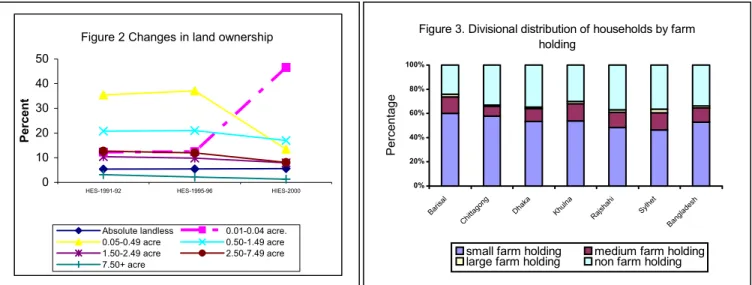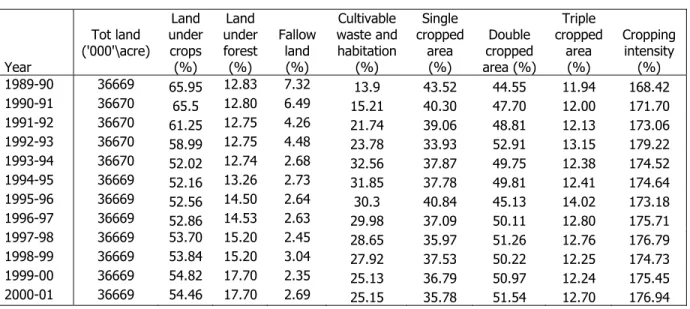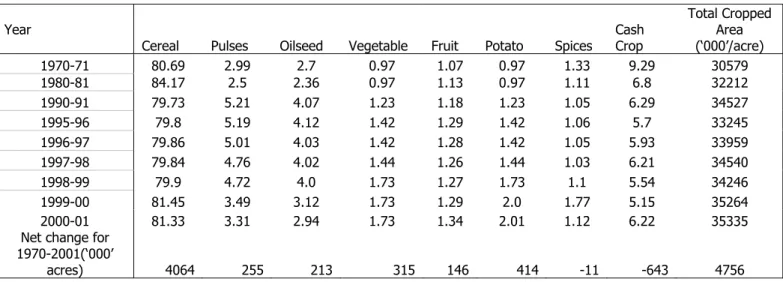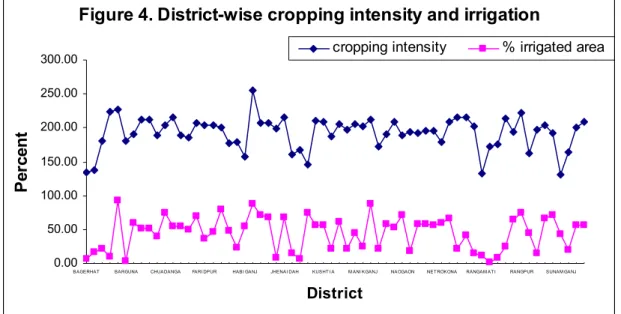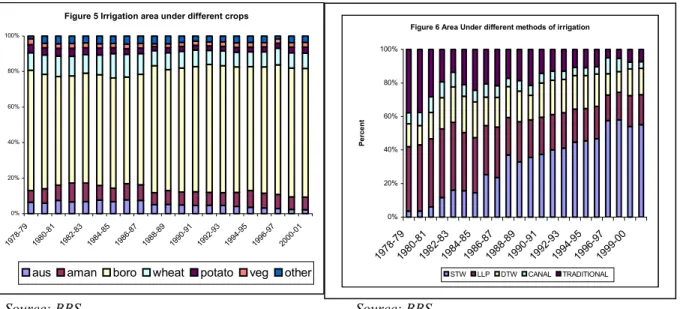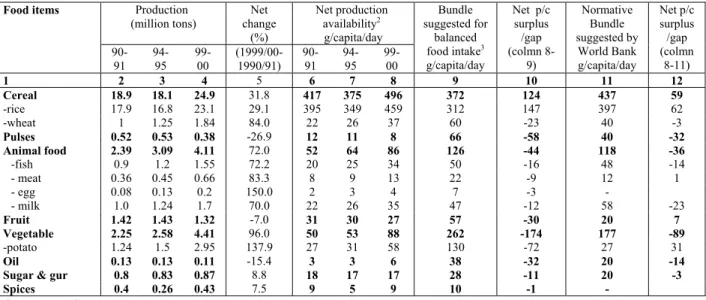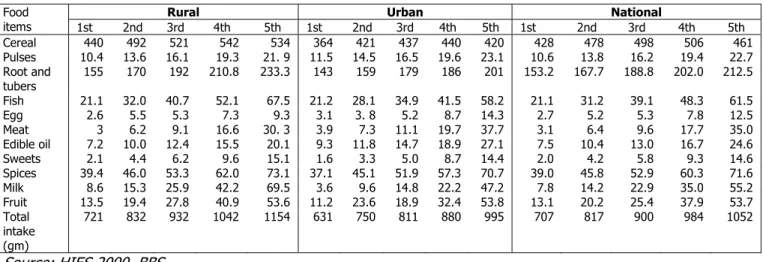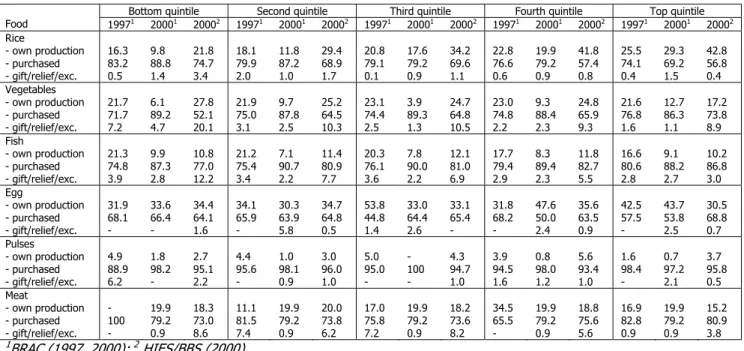List of indicators used in the baseline report for the Assessment of Food Insecurity and Vulnerability Status in Bangladesh. The effect of the 1998 flood on the lives of the poor and vulnerable: BRAC studies.
Methodology
The essential elements of the concept of food security are the availability of food, the ability to obtain it from the market and the ability to utilize the consumed food in the body system. Some of the surveys (given data whose published reports are used in this report) actually collected Upazila level data but did not put the results in the report.
Basic Information about Bangladesh
Bangladesh FIVIMS Baseline Report: Agricultural and Socio-Economics 17 districts with the lowest level in Patuakhai (only 1.3% of the total cropped area) and the highest in Bogra (92% of the total cropped area) (see figure 4). Irrigated bore-rice area accounted for almost three-quarters of the total irrigated area and the trend has been an increase in recent years.
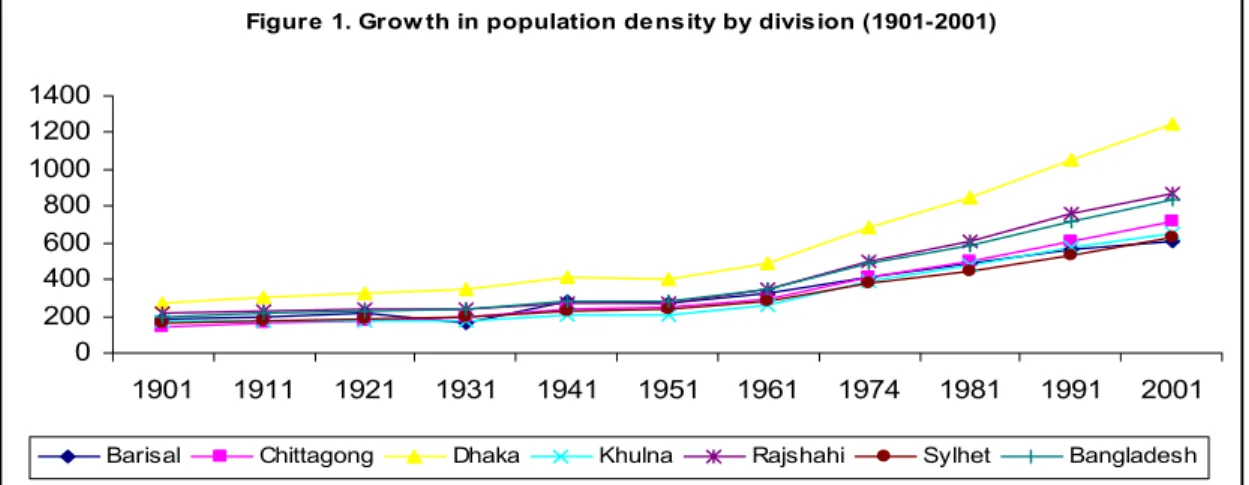
Food Production and Net Production Availability
In addition to the positive change in some food items, negative growth was also observed in some other food items. Total production of pulses (one of the main sources of protein for the poor), oilseeds and fruits has declined.
Food Production and the Balanced Diet
Bangladesh FIVIMS Basic Report: Agro- and Socio-Economics 21 According to the minimum food bundle prescribed by the World Bank, the country has largely achieved self-sufficiency levels in grain production and also in potato, fruit and meat production. According to the BBS's HES/HIES, total per capita consumption of major food products, both in terms of physical quantity and calories, increased significantly in the first half of the 1990s, but declined in the second half of the decade (both at the rural and urban areas). areas), the period during which a significant increase in the production of key food products was observed7. On the other hand, the results show that the consumption of legumes in rural areas, whose local production decreased in the second half of the 1990s, increased from 13 g/capita/day to 15 g/capita/day.
7 The contradiction between the impressive growth in production and the decrease in consumption in the latter part of the decade is difficult to explain. There is not much data on the sources of household food consumption, either from own production or purchased on the market or obtained as a gift, aid or exchange. In 2000, this trend was more pronounced: the share of own production increased even more, from 21.8% for the poorest to 42.8% for the richest.
The results of the Gini coefficient indicate a growing income inequality between the rural and urban populations in the late 1990s, with the growth rate in urban areas being twice that of rural areas (Table 12). The results, based on the poverty line score of 2, show a downward trend in extreme poverty in rural areas and in the country, both in absolute and percentage terms, and an increase in the absolute number of extreme poor in urban areas. According to HES data 1995-96, every sixth out of ten rural households was poor, as they consumed less than the prescribed 2122 kcal/inhabitant/day, and a significant proportion could not afford even 1600 kcal/inhabitant/day.
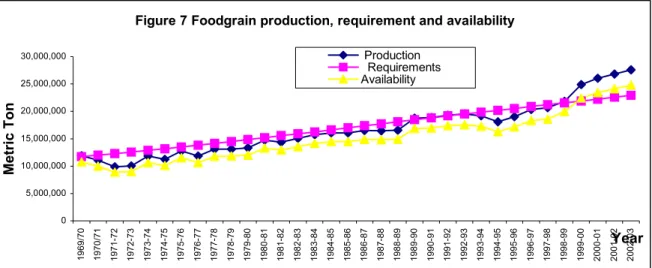
Food and non-food consumption expenditure
Bangladesh FIVIMS Core Report: Agro- and Socio-Economics 64 The pattern of food expenditure changed dramatically in the 1990s. On the one hand, per capita expenditure on food increased by 24% and 47% respectively in rural and urban areas, while on the other hand, the share of cereals, which was almost halved in 1991/92, decreased by almost a quarter, which means that expenditure on non-cereal products has increased. increased more in the 90s. Interestingly, per capita consumption of cereals was practically the same when in 1991/92 and 2000 actual expenditure on cereals in 2000 was 2% less than the amount spent on cereals in 1991/92, indicating a fall in prices rice in the late 1990s.
The increase in the share of expenses for fruit, meat, eggs and milk has come as a result of the increase in the amount of consumption and the increase in prices.
Household income
Bangladesh FIVIMS Basic Report: Agro- and Socio-Economics 65 Table 17: Percentage share of household income by decile group. In rural areas where 77% of the population lives, land ownership was considered a proxy indicator of household well-being. The contribution of different landholding groups to total income shows that reducing the number of large farmers reduces their share of total income.
The highest increase was for the 0.01-0.04 hectare land holding group (116%) and this group currently contributes about 37% to the total rural income. In 2000, the landless poor (owning 0.05-0.49 hectares of land) and marginal farmers owning more than 0.49 hectares but less than 2.5 hectares of land were in a negative balance by more than 100% of their income to various household food and non-food consumption items, although in 1991/92 they were able to maintain an annual savings of 10-12%. Changes in income and expenditure of the rural households in the nineties by size of land owned.
The dominance of agriculture in the share of income during the decade had fallen from 40.1% to 25.5%. The contribution of skilled employment and also business and trade, which together contributed about 32.5% to total income in 1991/92 had increased to 50.1% in 2000. The major positive improvement was in the business and trade sector. , especially in the second half of the decade (Table 19).
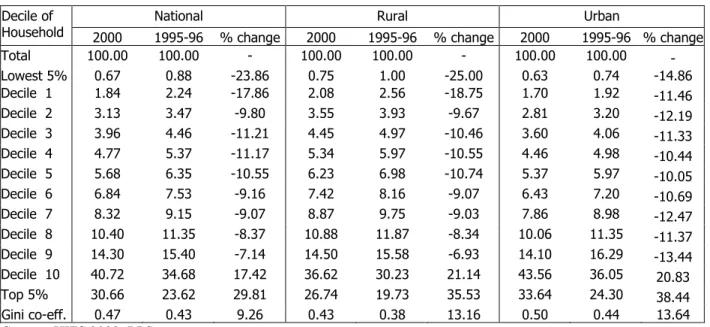
Food price and food insecurity
The CPI of Chittagong division has always been the highest and there has been a huge increase in the last two years, widening their gap behind other geographical regions. Usually, the price of rice is lower during the harvest months of pine (June-July), aus (August) and aman (December) (Figure 15). FIVIMS Basic Report for Bangladesh: Agro- and Social-Economics 68, which was even mentioned in the 1998 NSP Annual Report.
Data from the last census shows a rapid increase in female literacy in the 1990s, which has led to a slight reduction in the gender gap. FIVIMS Baseline Report for Bangladesh: Agro- and Socio-Economics 71 Different data sources provide different figures on adult literacy due to differences in working definitions adopted in survey methodologies. On the other hand, Education Watch 2002 used a stricter definition where more emphasis was placed on literacy and numeracy skills and the ability to use these skills in everyday life to function effectively in society - a definition proposed by UNICEF.
The definition adopted in the 2001 Census was somewhat of a compromise between the two, yielding moderate figures. CELS as a data source may have some problems with the manipulation of results as much of the district or division level data shows higher literacy rates for 1999 than for the year 2002 and this contradicts current government efforts to increase level of knowledge. education in the country (Figure 20). For the latter, the higher study population in urban slums and their lower enrollment rates significantly resulted in the lower outcome at the aggregate level.
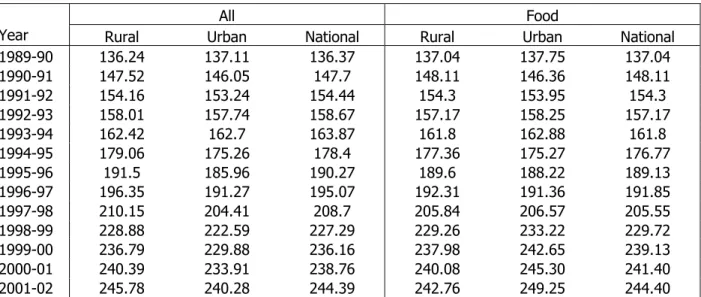
Access to infrastructure Access to electricity
On the other hand, Rangamati, Bandarban, Bhola, Sunamgonj, Khagrachari, Patuakhali and Kurigram are at the bottom of the list. Bangladesh FIVIMS Baseline Report: Agro- and Social-Economics 74 drought or cyclone - affects different parts of the country. According to the figure, more than 15% of the country's territory was sometimes flooded during the entire period 1964-1999 (with only a few exceptions).
Bangladesh FIVIMS Baseline Report: Agricultural and Socioeconomics 75 health during disaster; suffering of the women and adolescent girls during flood and the effect of flood on vegetable farmers. Many of the poor during the 1998 flood became displaced and moved with their basic possessions (tools and bedding) to the nearby shelters and relief camps. The flood has a serious effect on the food habits of the poor, both in quantity and quality.
The allocation of the VGF card was mainly based on the severity of the flood impact. Low purchasing power in the face of high market price of food grains due to less market availability affects the livelihood of poor and marginal farmers. FIVIMS Baseline Report for Bangladesh: Agro- and Socio-Economics 79 leakage of resources to the non-poor due to imperfect criteria used for targeting11.
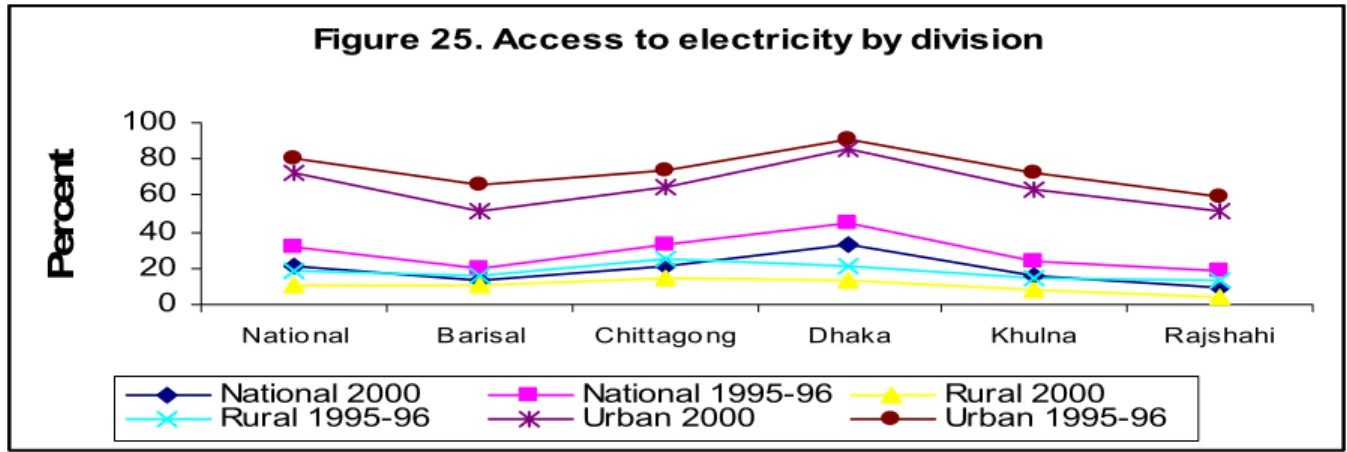
Identification of the Extreme Poor and Most Vulnerable Characteristics of the extreme poor and most vulnerable 12
Identification of the extremely poor and the most vulnerable Characteristics of the extremely poor and the most vulnerable12. For the average Bangladeshi individual, rice is the main source of his/her calories, contributing 75% of total calories. Consuming three meals of rice a day is an indicator of a household's standard of living, especially in our rural community.
Bangladesh FIVIMS Baseline Report: Agricultural and Socioeconomics 81 charged by some of the borrowers in the regions where the number of borrowers and the amount they borrowed were also significantly higher. So, to summarize, the distinguishing characteristics of the ultra poor, as revealed from the findings of the study, are that they usually have smaller households with more females than males. Their average value of a house is very low and the majority of the households are 'educationally dark'.
The socio-economic status of the extreme poor and their access to capital varied across regions. Identifying the ultra poor is always difficult as there is no universally accepted definition for it. By reviewing the available literature and also following its own research findings, BRAC has developed a set of criteria for identifying the ultra-poor.
Conclusions and recommendations
Bangladesh FIVIMS Baseline Report: Agricultural and Socioeconomics 82 cases households are not among the poorest. Rahman and Razzaque (2000) also claimed that a single criterion is not enough to define the ultra poor. Various indicators such as income, occupation, housing and physical characteristics, geographic location, gender of the household head and household dependency can also be considered.
Bangladesh FIVIMS Baseline Report: Agricultural and Socioeconomics 83 another debatable area where different estimates used by various data generating agencies produce different results. Poverty and food insecurity vary widely across geographic regions and the majority of data sources actually provide divisional and, on some indicators, district level information. 1998) 'Current interventions for the stubborn poor in Bangladesh and how to reach them with financial services' in Microfinance News, Vol.
Fighting Human Poverty: Bangladesh Human Development Report 2000, BIDS, January 1999), Hope not Complacency: State of Primary Education in Bangladesh 1999, Education Watch 1999, Campaign for Popular Education, The University Press Limited, August 1999, Dhaka. State of Primary Education in Bangladesh 2000, Education Watch 2000, Campaign for Popular Education, The University Press Limited, December 2001, Dhaka. Roy (1999), Impact of the 1998 Flood on Labor Markets and Food Security and the Effectiveness of Relief Operations in Bangladesh, FMRSP, IFFRI, Dhaka.
Foodgrain production and availability (1969/70-2002/03)
Effect of Flood 1998 and Govt. Relief Allocation by District
